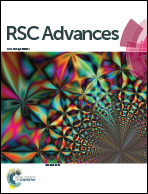Fabrication of a resist pattern based on plasma–polystyrene interactions†
Abstract
We report a straightforward method to fabricate resist patterns based on the interaction of oxygen plasma and polystyrene (PS) spheres within several minutes. The XPS results demonstrate that the resist pattern is formed by the PS fragments produced in the etching process. In the process, PS spheres not only serve as templates for patterning, but also provide PS fragments to form the resist pattern. The ultrathin resist (UR) pattern can serve as a mask for dry etching with the selectivity of 21 : 1. In addition, the resist pattern can be used as a template to selectively deposit silver nanoparticles because it can effectively block electrons.


 Please wait while we load your content...
Please wait while we load your content...